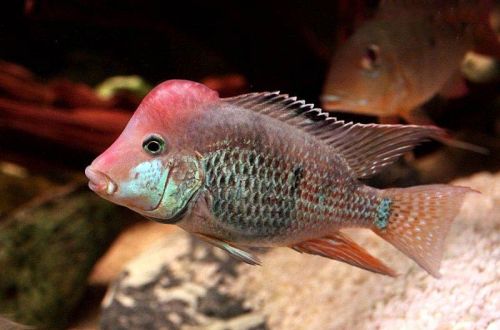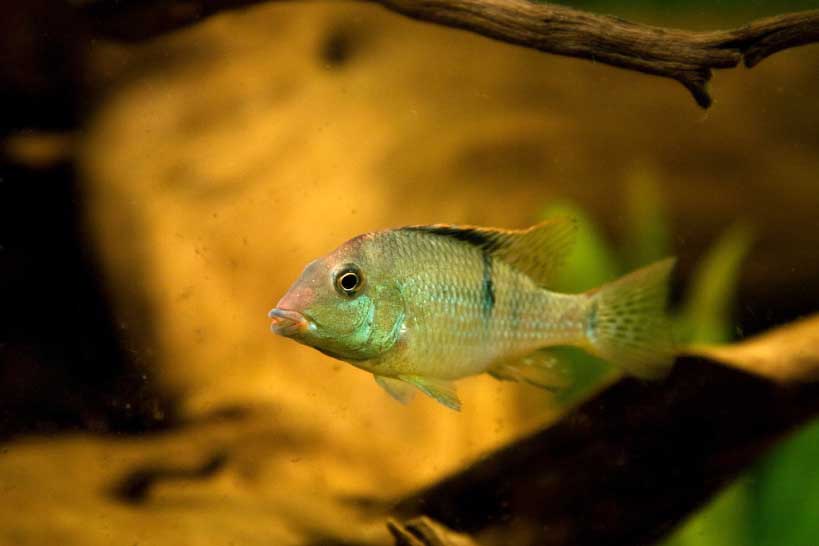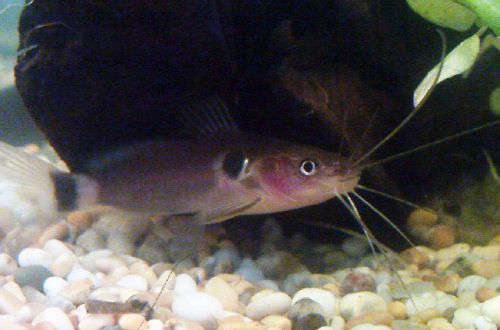
Геопхагус Стеиндахнер
Geophagus Steindachner, scientific name Geophagus steindachneri, belongs to the Cichlidae family. It is named after the Austrian zoologist Franz Steindachner, who first described this species of fish scientifically. The content can cause certain problems associated with the composition of the water and the characteristics of nutrition, therefore it is not recommended for beginner aquarists.

Садржај
Станиште
It comes from South America from the territory of modern Colombia. Inhabits the basin of the Magdalena River and its main tributary Cauka, in the north-west of the country. Found in a variety of habitats, but appears to prefer riverine patches through rainforest and calm backwaters with sandy substrates.
Кратке информације:
- Запремина акваријума - од 250 литара.
- Температура – 20-30°Ц
- Вредност пХ — 6.0–7.5
- Тврдоћа воде - 2-12 дГХ
- Врста подлоге - песковита
- Осветљење – пригушено
- Слатка вода – не
- Кретање воде је слабо
- Величина рибе је 11-15 цм.
- Храна – мала тонућа храна од разних производа
- Темперамент – негостољубив
- Harem-type content – one male and several females
Opis

Adults reach a length of about 11–15 cm. Depending on the specific region of origin, the color of the fish varies from yellow to red. Males are noticeably larger than females and have a “hump” on their heads characteristic of this species.
Храна
It feeds at the bottom by sifting sand in search of plant particles and various organisms contained in it (crustaceans, larvae, worms, etc.). In a home aquarium, it will accept various sinking products, for example, dry flakes and granules in combination with pieces of bloodworms, shrimp, mollusks, as well as frozen daphnia, artemia. Feed particles should be small and contain plant-derived ingredients.
Одржавање и нега, уређење акваријума
The optimal size of the aquarium for 2-3 fish starts from 250 liters. In the design, it is enough to use sandy soil and a few snags. Avoid adding small stones and pebbles that can get stuck in the fish’s mouth during feeding. The lighting is subdued. Aquatic plants are not required, if desired, you can plant several unpretentious and shade-loving varieties. If breeding is planned, then one or two large flat stones are placed at the bottom – potential spawning sites.
Geophagus Steindachner needs high quality water of a certain hydrochemical composition (slightly acidic with low carbonate hardness) and a high content of tannins. In nature, these substances are released during the decomposition of leaves, branches and roots of tropical trees. Tannins can also get into the aquarium through the leaves of some trees, but this will not be the best choice, as they will clog the soil that serves as a “dining table” for Geophagus. A good option is to use essences containing a ready-made concentrate, a few drops of which will replace a whole handful of leaves.
The main role in ensuring high water quality is assigned to the filtration system. Fish in the process of feeding create a cloud of suspension, which can quickly clog the filter material, so when choosing a filter, consultation with a specialist is required. He will suggest a specific model and placement method to minimize possible clogging.
Equally important are regular aquarium maintenance procedures. At least once a week, you need to replace part of the water with fresh water by 40–70% of the volume, and regularly remove organic waste (feed residue, excrement).
Понашање и компатибилност
Adult males are hostile to each other, so there should be only one male in the aquarium in the company of two or three females. Calmly reacts to representatives of other species. Compatible with non-aggressive fish of comparable size.
Узгој / узгој
Males are polygamous and with the onset of the mating season can form temporary pairs with several females. As a spawning ground, fish use flat stones or any other flat hard surface.
The male initiates courtship lasting up to several hours, after which the female begins to lay several eggs in batches. She immediately takes each portion into her mouth, and in that short period of time, while the eggs are on the stone, the male manages to fertilize them. As a result, the entire clutch is in the female’s mouth and will be there for the entire incubation period – 10-14 days, until the fry appear and begin to swim freely. In the first days of life, they stay close and, in case of danger, immediately hide in their safe shelter.
Such a mechanism for protecting future offspring is not unique to this fish species; it is widespread on the African continent in cichlids from lakes Tanganyika and Malawi.
Болести риба
Главни узрок болести лежи у условима притвора, ако прелазе дозвољени опсег, онда се неизбежно јавља супресија имунитета и риба постаје подложна разним инфекцијама које су неизбежно присутне у окружењу. Ако се појаве прве сумње да је риба болесна, први корак је провера параметара воде и присуства опасних концентрација продуката циклуса азота. Враћање нормалних/прикладних услова често подстиче зарастање. Међутим, у неким случајевима, медицински третман је неопходан. Прочитајте више о симптомима и третманима у одељку Болести акваријумских риба.





